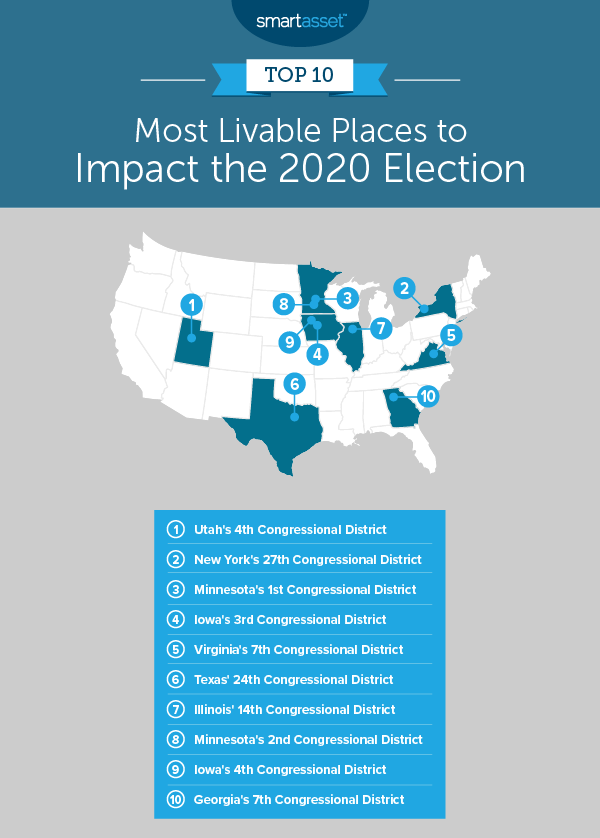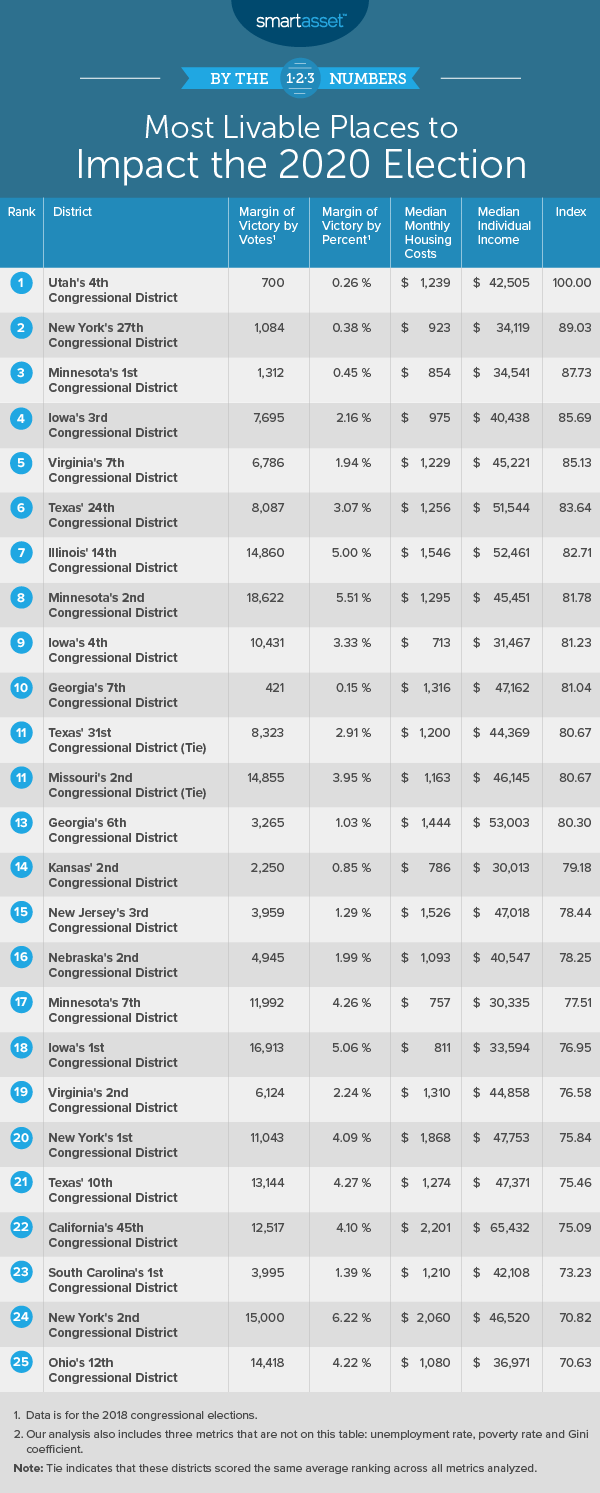December 4, 2019 – As the 2020 presidential race heats up, it’s important to remember there are significant political contests within the legislative branch, along with state and local elections, that can impact the political future of the U.S. For those who are most passionate about making an impact, voting in swing districts could be more appealing. And no matter where on the political spectrum they fall, voters who are considering moving to those places will be looking at livability as an important factor for where they decide to settle. At the federal level, all 435 seats of the House of Representatives and 35 of the total 100 seats in the Senate are up for election. State executive offices up for election in 2020 include 11 gubernatorial seats, nine lieutenant gubernatorial seats, 10 attorney general seats and seven secretary of state seats. With next November not far away, SmartAsset determined some of the most livable places where your votes may make the most difference in the 2020 elections.
Study Specifics
SmartAsset first considered all congressional districts in the 115th Congress. To create a list of swing districts, we found every congressional district where the margin of victory in the November 2018 House election was less than 15%. After gathering data on how close those races were, we looked at livability factors such as median income, median housing costs, poverty rate, unemployment rate and income inequality. For details on our data sources and how we put all the information together to create our final rankings, check out the Data and Methodology below.
Key Findings
- Many close 2018 congressional races. We looked at congressional districts where the margin of victory was 15% for both this study and a previous study called “Best Places to Move to Make an Impact in the 2018 Midterm Elections.” In 2016, there were 65 congressional districts with a margin of victory of less than 15%, and in 2018, there were 128, almost double the amount.
- Livable swing districts in the Midwest. Half of the top 10 livable places to impact the 2020 election are located in the Midwest. Specifically, two of the congressional districts are in Minnesota, two are in Iowa and one is in Illinois.

1. Utah’s 4th Congressional District
In November 2018, Democrat Ben McAdams won the seat for Utah’s 4th Congressional District by only 700 votes in his race against the Republican candidate, Mia Love. With a total of 269,271 votes cast, the margin of victory was only 0.26%, the second-lowest of any congressional district election, following only Georgia’s 7th Congressional District.
With an estimated 85% of the congressional district concentrated in Salt Lake County, the district is also very livable. In 2017, it had the 11th-lowest unemployment rate of any district in our study and ranks the best overall on our measure of income inequality, the Gini coefficient. A statistical measurement of wealth distribution using a scale of zero to one, where zero represents total equality and one represents total inequality across groups, the 2017 Gini coefficient in Utah’s 4th congressional district was 0.39.
2. New York’s 27th Congressional District
Located in western New York State, New York’s 27th Congressional District encompasses most of the eastern and southern suburbs of Buffalo. The incumbent Republic representative, Chris Collins, narrowly won the House seat in 2018. He had a margin of victory of 0.38%, or 1,084 votes, over Democrat Nate McMurray. Relative to other congressional districts, that is the third-lowest percentage margin of victory and fifth-lowest margin of victory in terms of counted votes.
On the five livability factors we considered, New York’s 27th congressional district had a low unemployment rate and poverty rate relative to other districts. The 2017 unemployment rate was 3.8%, the 22nd-lowest of the 128 swing districts, and 2017 poverty rate was 8.3%, the 32nd-lowest overall.
3. Minnesota’s 1st Congressional District
Minnesota’s 1st Congressional District ranked second in our previous study on the best places to move to make an impact in the 2018 midterm elections. According to Ballotpedia, Tim Walz, the Democratic representative who narrowly won in the 2016 congressional elections, did not seek reelection in 2018. As a result, two new candidates – Republican Jim Hagedorn and Democrat Dan Feehan – ran for the representative position in 2018. Hagedorn narrowly won by a margin of 0.45%, the fifth-tightest race in 2018 in terms of percentage.
Unemployment rates and housing costs are relatively low in the district. In 2017, the unemployment rate was 3.1%, the lowest in our top 10 and fifth-lowest overall. Additionally, median monthly housing costs were just $854, the 37th-lowest of all 128 districts.
4. Iowa’s 3rd Congressional District
In the 2018 congressional election, Democrat Cindy Axne won by 2.16%, or about 7,700 votes, against Republican candidate David Young in Iowa’s 3rd Congressional District. Additionally, according to Census estimates, the 2017 unemployment rate was 3.4%, the eighth-lowest of any congressional swing district. The close 2018 race and the district’s strong performance on livability metrics suggest that it may be a great place for people looking to move to a swing district.
5. Virginia’s 7th Congressional District
For the first time since the 1970s, a Democratic candidate won the congressional seat in Virginia’s 7th Congressional District in 2018. The margin of victory was only 1.94%, the 17th-lowest of all congressional races that year, indicating that each vote made a big difference. Moreover, on livability factors, the district ranks in the top half of the 128 congressional districts in our study on all but one factor – median monthly housing costs.
6. Texas’ 24th Congressional District
Incomes in Texas’ 24th Congressional District are relatively high compared to those in the majority of the other districts we considered. In 2017, the median annual income for an individual was $51,544, the 14th-highest of any congressional district in our study and second-highest across the congressional districts in our top 10.
7. Illinois’ 14th Congressional District
Part of northern Illinois and surrounding the outer northern and western suburbs of Chicago, Illinois’ 14th Congressional District counts Democrat Lauren Underwood as its representative. In the 2018 election, she won the seat by a margin of 5% over her Republican opponent, Randy Hultgren. Though this is a wider margin than the margin in eight other districts in our top 10, the district does well in terms of livability. Incomes in Illinois’ 14th Congressional District are high, surpassing even those in Texas’ 24th Congressional District. Specifically, the median individual income within the district was almost $52,500 in 2017, the highest of any district in our top 10 and 10th-highest of all 128 districts in our study.
8. Minnesota’s 2nd Congressional District
Though the margin of victory in terms of both percentage and number of votes was not as close in 2018 in Minnesota’s 2nd Congressional District than in many other districts in our top 10, the district ranks in the top 40 of our study on four of the five livability factors. It has the 15th-lowest unemployment rate, sixth-lowest poverty rate, fifth-lowest Gini coefficient and 37th-highest median individual income.
9. Iowa’s 4th Congressional District
Housing costs in Iowa’s 4th Congressional District are the lowest of any district in our top 10. According to Census estimates, 2017 median monthly housing costs were $713, meaning that residents would spend a rough average of $8,500 on housing annually. In the most recent congressional election, Republican Steve King narrowly won the seat against Democrat J.D. Scholten by a margin of 3.33%, or 10,431 votes.
10. Georgia’s 7th Congressional District
Georgia’s 7th Congressional District rounds out our list with the tightest 2018 congressional election of any district in the U.S. The spread between the victor, Republican Rob Woodall, and runner-up, Democrat Carolyn Bourdeaux, was only 0.15%, or 421 votes. On the five livability factors, Georgia’s 7th district scored particularly well for the metric of median individual income. According to Census estimates, the 2017 median individual income for residents in the district was more than $47,000 and the 28th-highest of all 128 congressional districts in our study.

Data and Methodology
In order to find the most livable places to make a difference in the 2020 elections, we looked at data on all 128 congressional districts where the margin of victory in the 2018 congressional elections was less than 15%. Specifically, we looked at data on the following seven factors:
- Margin of victory by votes. Races that were closer ranked higher. Data comes from Ballotpedia and is for the 2018 congressional elections.
- Margin of victory by percentage. Races that were closer ranked higher. Data comes from Ballotpedia and is for the 2018 congressional elections.
- Unemployment rate. Data comes from the Census Bureau’s 2017 1-year American Community Survey.
- Poverty rate. Data comes from the Census Bureau’s 2017 1-year American Community Survey.
- Gini coefficient. This is a statistical measurement of income inequality. A Gini coefficient of zero indicates total equality of wealth distribution while a coefficient of one indicates total inequality of wealth distribution across groups. Data comes from the U.S. Census Bureau’s 2017 1-year American Community Survey.
- Median monthly housing costs. Data comes from the Census Bureau’s 2017 1-year American Community Survey.
- Median annual individual income. Data comes from the Census Bureau’s 2017 1-year American Community Survey.
We created our final ranking by first ranking each district for each metric. We then found each district’s average ranking, giving all metrics equal weight. We used this average ranking to determine a final score. The district with the best average ranking received a score of 100 and the district with the lowest received a score of 0.
Tips for Finding a Home
- Make sure you can handle a mortgage. Just as pledging your vote and upholding your civic duty is a big commitment, so too is deciding to secure a mortgage for a new home. Be certain you’ll be able to afford whatever you’ll end up having to pay. Use SmartAsset’s mortgage calculator to see the ideal range in which you should be shopping.
- Get trusted personal finance advice. A financial advisor can help you make smarter financial decisions such as moving or being in better control of your money after you land a new job. Finding the right financial advisor who fits your needs doesn’t have to be hard. SmartAsset’s free tool matches you with financial advisors in your area in 5 minutes. If you’re ready to be matched with local advisors that will help you achieve your financial goals, get started now.
Questions about our study? Contact us at press@smartasset.com
Photo credit: ©iStock.com/evrim ertik
